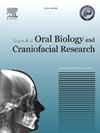Influence of age, sex, and presence of cleft lip and palate on the quantity and quality of saliva-derived DNA
Q1 Medicine
Journal of oral biology and craniofacial research
Pub Date : 2025-02-10
DOI:10.1016/j.jobcr.2025.01.030
引用次数: 0
Abstract
The quantity and quality of DNA are crucial factors in determining polymorphisms in samples from individuals with and without pathologies such as cleft lip and palate (CL/P). Saliva is increasingly being evaluated as a collection method. This study aimed to compare saliva DNA concentrations from individuals of different ages with and without CL/P.
Saliva samples were collected, DNA was extracted and the quantification was performed by spectrophotometry. Kruskal-Wallis test was used to compare frequencies between groups, and Spearman's rho for correlations.
We obtained saliva DNA from 314 individuals: 107 with CL/P (mean age: 12.7 ± 6.5 years), 103 parents of children with CL/P (mean age: 41.1 ± 9.3 years), 52 individuals without CL/P under 18 years old (controls), and 52 individuals without CL/P over 18 years old (controls). The sample comprised 32.2 % females and 67.8 % males.
Statistically significant differences in DNA concentrations were found between individuals under and over 18 years old (12.38 and 21.3 ng/μl, respectively, p = 0.0001), but no differences were observed between males and females. Individuals with CL/P had lower DNA concentrations (12.45 ng/μl) compared to their parents and controls (21.95 and 21.15 ng/μl, respectively). Our results showed a direct correlation between age and DNA concentration in individuals with CL/P under 18 years old (R = 0.328).

年龄、性别和唇腭裂对唾液来源DNA数量和质量的影响
DNA的数量和质量是确定有或没有唇腭裂(CL/P)等病理个体样本多态性的关键因素。唾液越来越多地被评价为一种收集方法。本研究旨在比较不同年龄个体的唾液DNA浓度,有无CL/P。采集唾液样本,提取DNA,分光光度法定量。Kruskal-Wallis检验用于比较各组之间的频率,并使用Spearman的rho来表示相关性。我们获得了314例患者的唾液DNA: 107例患有CL/P(平均年龄:12.7±6.5岁),103例患有CL/P儿童的父母(平均年龄:41.1±9.3岁),52例18岁以下无CL/P(对照组),52例18岁以上无CL/P(对照组)。样本中女性占32.2%,男性占67.8%。18岁以下和18岁以上个体的DNA浓度差异有统计学意义(分别为12.38和21.3 ng/μl, p = 0.0001),但男女之间无差异。CL/P组个体的DNA浓度(12.45 ng/μl)低于亲本(21.95 ng/μl)和对照(21.15 ng/μl)。结果显示,年龄与18岁以下CL/P个体DNA浓度直接相关(R = 0.328)。
本文章由计算机程序翻译,如有差异,请以英文原文为准。
求助全文
约1分钟内获得全文
求助全文
来源期刊

Journal of oral biology and craniofacial research
Medicine-Otorhinolaryngology
CiteScore
4.90
自引率
0.00%
发文量
133
审稿时长
167 days
期刊介绍:
Journal of Oral Biology and Craniofacial Research (JOBCR)is the official journal of the Craniofacial Research Foundation (CRF). The journal aims to provide a common platform for both clinical and translational research and to promote interdisciplinary sciences in craniofacial region. JOBCR publishes content that includes diseases, injuries and defects in the head, neck, face, jaws and the hard and soft tissues of the mouth and jaws and face region; diagnosis and medical management of diseases specific to the orofacial tissues and of oral manifestations of systemic diseases; studies on identifying populations at risk of oral disease or in need of specific care, and comparing regional, environmental, social, and access similarities and differences in dental care between populations; diseases of the mouth and related structures like salivary glands, temporomandibular joints, facial muscles and perioral skin; biomedical engineering, tissue engineering and stem cells. The journal publishes reviews, commentaries, peer-reviewed original research articles, short communication, and case reports.
 求助内容:
求助内容: 应助结果提醒方式:
应助结果提醒方式:


